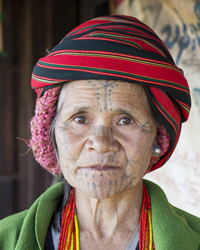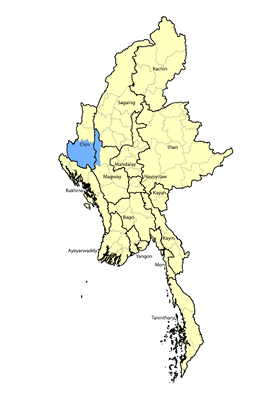Until now, the Ng’ga have never appeared on any lists of the world’s people groups. Researchers tend to view communities according to their area of interest. Linguists are interested in a group’s language, and anthropologists focus on cultural aspects. Ng’ga identity is not dependent on any one aspect, however, and the few people who have made the effort to visit the remote Ng’ga area invariably come away with a sense that they are a proud, independent tribe with their own identity and culture, and that they should not be grouped together under the banner of any other ethnicity, as many scholars have done. Despite their similar names, the Ng’ga are not the same as the Ng'hang, who are a subgroup of the Daai Chin tribe located further to the west.
Location: With a population estimated at 3,800 people distributed across 20 villages in the eastern part of Myanmar’s Chin State, the Ng’ga are a little-known tribe hidden away in the remote mountains of Kanpetlet and Mindat townships. In Chin State, the Ng'ga are bordered by the Cho to the north and the Daa Yindu to the south and east. This small tribe also spills across the state border into western Magway Region. The Ng’ga territory is extremely undeveloped. Of the 117 villages in Kanpetlet Township, only 13 have a road leading to them. The remaining 104 communities must be accessed on foot, often along narrow and treacherous paths. Kanpetlet also contains Mt. Victoria, the highest peak in the Chin Hills at 10,016 feet (3,053 meters) above sea level, and the Natmataung National Park, which is home to some of the world’s rarest bird species.
Language: Little research has ever been conducted into the Ng’ga language to determine its relationship to other Chin varieties, although in the past it was considered a dialect of Songlai, which is spoken a considerable distance away in southwest Chin State and adjacent parts of Rakhine State. Ng’ga, which is one of hundreds of Tibeto-Burman languages spoken in this part of Asia, is used extensively by the people and is not in any danger of disappearing.
Ng'ga history has been influenced by their location, which in a sense sits at the crossroads of Buddhism, Animism, and Christianity in western Myanmar. To the east, the plains of Myanmar are populated by millions of Buddhists. The town of Sidoktaya, in the eastern part of the Ng’ga area, was established almost a thousand years ago, in 1098, and contains many ancient Buddhist temples and pagodas. Dozens of strong Christian tribes are found further north and west of the Ng’ga area in Chin State, but in the isolated homeland of the Ng'ga, spirit worship prevailed for many centuries and still forms the backbone of their society.
The Ng'ga are one of the few tribes in the Chin Hills that still tattoo the faces of their young girls, although the practice is fading with time. Traditionally, their tattoos were long vertical lines interspersed with dots. Tattoos were made “using leaves, soot, and grass shoots. The leaves gave color, the soot acted as a disinfectant, and the grass shoots were added at the end, acting as a bandage and natural healing cover. The concoction was applied to the face using sharp cane thorns which pricked the skin to create the pattern.”
Although about 65 percent of Ng’ga people today are professing Buddhists, their faith is deeply intertwined with the animistic practices of their forefathers, who placated a myriad of demons and protective spirits in a bid to secure blessings on their communities.
Although a handful of churches now exist among the Ng’ga Chin people, many villages in the mountains have never been exposed to the Gospel, while others have been taught that Christianity is a threat to their culture and heritage and so have resisted the faith. No Christian resources of any kind exist in the Ng’ga Chin language, and most of this group remains unreached and unevangelized.
Scripture Prayers for the Ng'ga in Myanmar (Burma).
| Profile Source: Asia Harvest |











